汽车发展史英文
汽车发展史英文文献

汽车发展史英文文献The Evolutionary Journey of Automobiles: From Steam-Powered to Modern Electric Vehicles.The history of the automobile is a remarkable narrative of innovation, perseverance, and engineering genius. Spanning multiple centuries, it tells a tale of continuous progress, evolution, and revolution in transportation. From the steam-powered carriages of the 18th century to the electric and autonomous vehicles of today, the automobile industry has witnessed significant milestones that have forever altered the face of transportation.The earliest precursors of the modern automobile were steam-powered carriages. These vehicles, which first appeared in the late 18th century, were bulky, slow, and often unreliable. However, they marked the beginning of a revolution in transportation, as they provided a new mode of conveyance that was not dependent on horses or other animals.In the early 19th century, several inventors and engineers began to experiment with alternative power sources for vehicles. One such individual was Nicholas-Joseph Cugnot, a French military engineer who designed and built the first self-propelled mechanical vehicle in 1769. Dubbed the "Cugnot's Fardier," this steam-powered vehicle was used by the French army to haul artillery.However, it was the German engineer Rudolf Diesel who truly revolutionized the automobile industry. In 1897, he successfully developed the first diesel engine, which operated on the principle of compression ignition. This engine was efficient, powerful, and offered a significant advantage over the gasoline engines of the time. Diesel's invention not only found widespread application in heavy-duty vehicles and locomotives but also paved the way for the development of more efficient and powerful automobiles.The turn of the 20th century marked a period of rapid innovation and growth in the automobile industry. In 1885, Karl Benz patented the first gasoline-powered automobile,the Benz Patent Motorwagen. This vehicle, which was powered by a two-stroke engine, marked the beginning of a new erain transportation. Soon after, other manufacturers began to produce their own versions of gasoline-powered cars, andthe industry began to grow rapidly.By the early 20th century, the automobile had become a popular mode of transportation for both personal and commercial use. Automobiles were now being produced inlarge numbers, and the industry was experiencing rapid growth. However, this growth was not without its challenges. The early automobiles were noisy, smelly, and emitted large amounts of exhaust fumes, which led to concerns about their impact on public health and the environment.The 1920s and 1930s saw further innovation and improvement in automobile technology. Manufacturers beganto experiment with new materials and designs, resulting in lighter, more aerodynamic vehicles. The internal combustion engine also underwent significant improvements, becoming more efficient and powerful. Additionally, the introduction of electric starters and self-starters made it easier tooperate automobiles, and the development of better roads and infrastructure further facilitated the growth of the automobile industry.The post-World War II era marked a new phase in the evolution of the automobile. With the advent of new technologies and materials, manufacturers were able to produce safer, more comfortable, and more efficient vehicles. The introduction of disc brakes, power steering, and automatic transmissions significantly improved the driving experience, while the development of high-performance materials like fiberglass and kevlar led to lighter and stronger vehicles.In recent years, the automobile industry has been transformed by the advent of electric vehicles (EVs) and autonomous driving technology. EVs, which are powered by batteries instead of fossil fuels, offer a more environmentally friendly and cost-effective mode of transportation. Autonomous driving technology, which uses sensors and algorithms to navigate and control vehicles without human intervention, has the potential torevolutionize the way we travel.The automobile industry has come a long way since its humble beginnings as steam-powered carriages. From gasoline-powered cars to electric and autonomous vehicles, the industry has continuously evolved and adapted to meet the changing needs and demands of society. As we look towards the future, it is exciting to imagine what new technologies and innovations will further transform the face of transportation.。
汽车发展史 英文资料
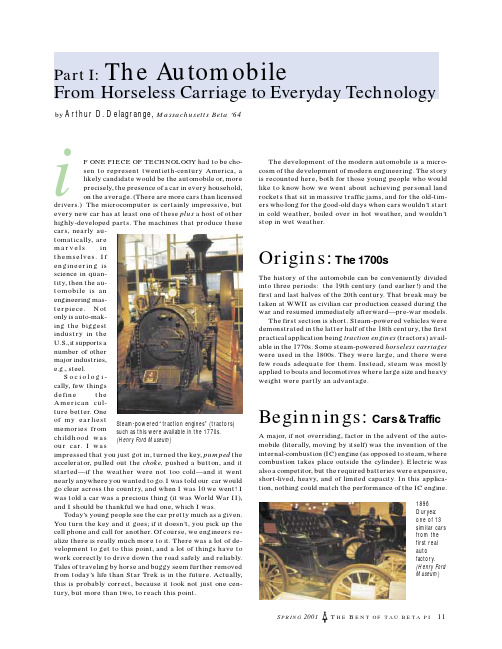
by Arthur D. Delagrange, Massachusetts Beta ’64F ONE PIECE OF TECHNOLOGY had to be cho-sen to represent twentieth-century America, a likely candidate would be the automobile or, more precisely, the presence of a car in every household,on the average. (There are more cars than licenseddrivers.) The microcomputer is certainly impressive, but every new car has at least one of these plus a host of other highly-developed parts. The machines that produce these cars, nearly au-tomatically, are marvels in themselves. If engineering is science in quan-tity, then the au-tomobile is an engineering mas-terpiece. Not only is auto-mak-ing the biggest industry in the U.S., it supports a number of other major industries,e.g., steel.S o c i o l o g i -cally, few things define the American cul-ture better. Oneof my earliest memories from childhood was our car. I wasimpressed that you just got in, turned the key, pumped the accelerator, pulled out the choke, pushed a button, and it started—if the weather were not too cold—and it went nearly anywhere you wanted to go. I was told our car would go clear across the country, and when I was 10 we went! I was told a car was a precious thing (it was World War II),and I should be thankful we had one, which I was.Today’s young people see the car pretty much as a given.You turn the key and it goes; if it doesn’t, you pick up the cell phone and call for another. Of course, we engineers re-alize there is really much more to it. There was a lot of de-velopment to get to this point, and a lot of things have to work correctly to drive down the road safely and reliably.Tales of traveling by horse and buggy seem further removed from today’s life than Star Trek is in the future. Actually,this is probably correct, because it took not just one cen-tury, but more than two, to reach this point.The development of the modern automobile is a micro-cosm of the development of modern engineering. The story is recounted here, both for those young people who would like to know how we went about achieving personal land rockets that sit in massive traffic jams, and for the old-tim-ers who long for the good-old days when cars wouldn’t start in cold weather, boiled over in hot weather, and wouldn’t stop in wet weather.Origins:T he 1700sThe history of the automobile can be conveniently divided into three periods: the 19th century (and earlier!) and the first and last halves of the 20th century. That break may be taken at WWII as civilian car production ceased during the war and resumed immediately afterward—pre-war models.The first section is short. Steam-powered vehicles were demonstrated in the latter half of the 18th century, the first practical application being traction engines (tractors) avail-able in the 1770s. Some steam-powered horseless carriages were used in the 1800s. They were large, and there were few roads adequate for them. Instead, steam was mostly applied to boats and locomotives where large size and heavy weight were partly an advantage.Beginnings:Cars & T rafficA major, if not overriding, factor in the advent of the auto-mobile (literally, moving by itself) was the invention of the internal-combustion (IC) engine (as opposed to steam, where combustion takes place outside the cylinder). Electric was also a competitor, but the required batteries were expensive,short-lived, heavy, and of limited capacity. In this applica-tion, nothing could match the performance of the IC engine.Steam-powered “traction engines” (tractors)such as this were available in the 1770s.(Henry Ford Museum)1896Duryea:one of 13similar cars from the first real auto factory.(Henry Ford Museum)iThere is some argument, but the first car is generally credited to Benz in Germany. In 1885, he designed, as an integral unit, a 3/4 hp, 8mph three-wheeler (it still exists) with a surprising number of features still used, including a four-stroke gasoline engine with electric ignition and a differential. The first automobile factory likely belonged to the Duryea Brothers in Massachusetts, who produced 13 similar cars in 1896.By 1900 there were more than 100 brands. Early vehicles were mostly built one-at-a-time, sometimes entirely by the builder, and were often to a customer’s specifications. This made them very expensive, but it was understood they were for the rich. As quantities increased, sec-tions were farmed out, particularly the coachwork, which was often of parlor quality. When Ransom E. Olds suffered a fire in his factory, he contracted out nearly everything and became basically a designer/as-sembler. Some of Ford’s early cars used almost entirely parts made by the Dodge brothers, who did not sell a car of their own—yet.The early twentieth century was dotted with the names of pioneers,some becoming rich from cars that bore their names, some winding up broke, and several doing both: Chevrolet, Ransom E. Olds (Oldsmobile and REO), Ford, Dodge, Chrysler, Cord, Duesenberg, Firestone, Benz,Bugatti, Buick, Daimler, Renault, Packard, Studebaker, Dunlop,Michelin, Mitsubishi, Bentley, Citroen, Peugeot, Rolls, and Royce. Some attempts were made to produce an inexpensive car, notably by Olds,but it was Henry Ford who succeeded beyond anyone’s imagination. He made some decisions that revolutionized the industry (although some of these were apparently accidental), and he made some bad decisions, too.He felt it wrong to charge too much for a car, and hit a more favorable spot on the s u p p l y /d e -mand curve.The product of many buy-ers times a low price turned out to be much more than a few buyers times a high price.Ford was also persuaded by his partner that workersshould be treated and paid better.They reduced the workday from nine hours to eight and nearly dou-bling the prevailing wage rate. This gave Ford the pick of the work force and worker loyalty, at least for a while. He set a speed record, 91 or 100 mph, depending on the account, personally driving a car of his own design at considerable risk. He was also responsible for the first re-corded auto accident, running his first car over a pedestrian, who went on his way once the spindly car was lifted off him.Ford’s crowning achievement was the Model T in 1908. To achieve his goals, he had to cut costs and improve efficiency. The key was an assembly line producing identical cars in huge quantities. Ford didn’t invent assembly line mass production, but he mastered it. He may have invented the moving assembly line, which produced a “steady stream of cars flowing forth” from the factory. Everything was carefully engi-neered to support the process. Parts suppliers, eager to be chosen for the huge quantities used, were required to ship the parts in boxes made with certain-size boards with certain-size holes drilled in specific places.These re-appeared in the cars as floorboards (hence the name). The T was a front-engine, rear-drive layout. It used a water-cooled four-cycleengine and would exceed 40 mph. The transmission used epicyclic (plan1908 Model T Ford: the start of major mass production. (Henry Ford Museum)FORD FLATHEAD V-8In 1932 Ford advanced from a four-cylinder engine directly to a V-8. The result established the Ford name for performance, but it was almost a disaster. Being frugal, Ford did not want to add an oil pump but wanted to stay with splash lubrication. His engineers finally persuaded him that the power achieveddestroyed the engine without it.Ford was also overly optimistic as to making an integral V-8block with the casting tech-niques of the day, and many defective blocks had holes welded in order to get enough engines built.The engine clearly reflected its lineage; the two sides were nearly independent: twin water pumps had twin hoses from the radiator, which had twin return hoses from the heads. Thedistributor had twin caps for the two sides. The carburetor had two barrels, each pretty much feeding its side. Oddly, it had but a single exhaust, a tortuous design where the two manifolds were connected together and only one was connected to the exhaust pipe.The Chevrolet straight-6 was a nicer design, theoretically, being inherently balanced, whereas the V-8 was not. But this was of little consolation when one was literally left in the dust . Perfor-mance was especially exciting because Ford resisted changing from mechanical brakes to hydraulic. The Ford flathead V-8was the choice of hot rodders for decades, and performance parts are still made for it today!etary) gears, which would be replaced later, only to re-appear in auto-matic transmissions.But the production line had its downside. Workers, installing the same part hour after hour as the line moved faster and faster, began to envy the freedom and individuality of the farmer, even at more work for less pay. It was called dehumanizing , certainly true in the sense that Ford sought to eliminate human error. Ironically, the first big labor demon-stration in the industry was directed at Ford, who had originally im-proved the worker’s lot. He responded with force against the union, which quickly learned the tactic. He was ready to close his plant rather than admit a union, until his wife persuaded him otherwise.Ford reduced the price of the Model T several times, finally down to $260. The ubiquitous T sold 15,000,000 cars in 20 years, more than any other model until the Volkswagen Beetle broke the record in the 1990s,but only after a production run of more than half a century. In some countries, and indeed parts of the U.S.A., Ford became synonymous for car . Ford tried to enjoy the success too long. He believed that if the car did the job, there was no reason to change it. Meanwhile, other makers were offering improved models. Sloan of General Motors (GM) created the concept of regularly introducing new models, planned obsolescence .But Ford came up with a trick of his own. He terminated production of the Model T before the new Model A was ready! All the details of the A were kept secret: no specifications, no pictures, no price, nothing. (Ap-parently, industrial espionage was not in vogue yet.) The suspense and speculation created a new type of market. When the A finally appeared,it was not outstanding. Nevertheless, dealers took 400,000 orders in thefirst two weeks!On the other end of the scale, many others tried their hands at making auto-mobiles, typi-cally after working for an e s t a b l i s h e d company. In e n g i n e e r i n g terms, some of these were masterpieces.There is little on today’s carsthat wasn’t at least tried before WWII. But economically, most firms were failures in the sense that they didn’t produce a large number of cars or stay in business for a long time. In fact, a surprising number of companies never got as far as actually selling a car. The Depression elimi-nated many of them. The number of brands available today may be be-wildering, but it is small compared to the number that no longer exist.The Complete Encyclopedia of Motorcars lists more than 300 makes un-der the letter A alone!Cars quickly changed the American landscape, filling in the spaces be-tween the towns. Motor hotels , later shortened to motels were built along the highway. Ford himself, with his friends Harvey Firestone and Thomas Edison (for whom he had worked), pioneered the motoring vacation. In 1913 the Gulf Refining Company opened the first filling station; previ-ously motorists had to drive to a railroad station and fill from a tank ernment, rather than supporting the wonderful invention, con-sidered it a nuisance and discouraged it with high taxes and low speed limits. Bad technical design was purposely used to avoid repressive regu-lations, but the concept was too powerful to kill.Willys-Overland Jeep : THE vehicle of WWII.(Walter P. Chrysler Museum)Production of civilian cars ceased shortly after the country’s entry into WWII. All industry turned to manufacturing war materiel. Even re-placement parts to keep the existing cars going were sometimes un-available. Gasoline was rationed, but if you needed extra, you just bought tickets from someone else, and the free market continued as the black market. Tires, the fastest wearing parts on the car, were nearly unavail-able, but they used inner tubes, which were. If the tire were torn too badly to contain the tube, “boots” (essentially pieces of ultra-heavy tube) were available to cover the hole. The main problem was that the supply of natural rubber from the Orient had been intercepted by the Japa-nese. This led to the development of synthetic rubber, which turned out to be better anyway.The best-known vehicle of WWII was the Army’s general-purpose vehicle, abbreviated GP, which came to be pronounced Jeep, now a reg-istered trademark. In 1939 the Army sought a lightweight, but tough, utility vehicle. The first successful models were built by Bantam, but the contract was awarded to Willys-Overland Company. With Ford also producing the vehicle under forced license, 660,000 were produced for WWII. It had four-wheel-drive (4WD), unusual back then, and was known for chewing through muck while everything else was getting stuck. Aside from the complexity of 4WD, it was simple and rugged. If the defrosters couldn’t keep up with the snow, which was most of the time, you disassembled the top, folded down the windshield, and sol-diered on. At one time Jeep was used to signify any 4WD vehicle. A notable anomaly was the ubiquitous U.S. postal jeep (neither rain, wind, nor snow, etc.), which was 2WD.After WWII, Willys redesigned the Jeep slightly for civilian use and designated it the CJ for civilian Jeep. Willys-Overland was taken over by Kaiser in 1953 and then by American Motors Corporation (AMC) in 1970. After a model run of 33 years with minimal changes, the CJ was replaced by the YJ, allegedly for yuppie Jeep, although never officially acknowledged. AMC became dominated by Renault and then was bought entirely in 1988 by Chrysler, now part of Daimler-Chrysler. The Jeep survived all of this and is now a complete line, all 4WD.Post WWIIAt the end of WWII, the mighty wartime industry returned to manu-facturing cars for the public in record numbers as fast as factories could be reconverted and scarce supplies replenished. These were bought hun-grily by returning military personnel who had not been home to spend their pay and by civilians, who had not spent theirs because there were few goods to buy. Initially, the cars were the same as before the war, but the industry was already preparing for explosive growth. If the economy could produce millions of vehicles to be destroyed, why not millions for good use? In 1946 the miles of surfaced roads exceeded the unsurfaced total for the first time.American manufacturers began making their cars look different with sheet metal, chrome, and ornaments, but underneath they were pretty much the same: water-cooled flathead V-8 or straight-6 engine, front-mounted, rear drive. Automatic transmissions were just beginning, and some were not fully automatic. Independent front suspension was be-ginning to replace beam axle. Rear was solid or live-axle with leaf springs. Although far from optimum, the combination was quite ad-equate, serviceable, and reliable. Options consisted of: exterior color, whitewall tires, radio (AM only), heater/defroster, and cigarette lighter. Generally not available were: power steering, power brakes, power windows/door locks, air conditioning, any safety equipment, or any sortof sound reproduction.1950s:T he Modern AutomobileAll that changed in the 1950s. If one decade were selected out of the century as that of the automobile, it would be the fifties. By now most families again had a car; the industry set out to convince them they needed a new one, perhaps more than one! Each model year was im-proved, mostly restyled. Options proliferated even for the less expen-sive brands: a range of models within each brand, a variety of engines,standard or overdrive or automatic transmission, anti-spin differential,power accessories, air conditioning, two-tone paint, seat belts, full-wheel covers (very important), fender skirts, and continental kits for the spare tire. Low-profile tubeless tires were introduced, and wheel diameter was reduced to 15 inches, and then 14, to lower vehicle height. It was assumed that each year’s models would be slightly bigger, heavier, bet-ter, and, of course, more expensive than the previous year’s. The luxury marque would, over a few years’ span, be downgraded and replaced with a new name and eventually be relegated as the economy model. Compe-tition was fierce, but it consisted more of copying than innovating. In-dustrial spying was becoming big business. Although model changes had to be planned years in advance, features in one make were invari-ably reflected in the others. Grilles in Fords and Chevys had an un-canny resemblance. One year it was noted that the prices of the base models from the big three were within $20 of each other.I might be slightly biased, because it was the year I got my license,but 1955 seemed to be the outstanding year of the outstanding decade.Chevrolet put the first V-8 in its passenger cars, and it was overhead valve (OHV) and a potent engine. Plymouth had a V-8 for the first time.Ford had gone OHV the year before, but horsepower was up for 1955.Chrysler upped the horsepower of its hemi engine to 300 for a special new model. The 300 series endures today. Styling completed the transi-tion from bulbous to boxy. Chrome was an integral, or even defining,element of the styling. That great American icon, the tailfin, had spread from Cadillac to all makes, although in modest form at first. With the V-8’s popularity came dual exhaust. A beltline chrome strip separated the body into halves for two-tone paint (or three!). The buyers loved it all;by the end of 1955 there were twice as many cars in the country as in 1945.Another notable year was 1958, but in this case it was a bit negative.It was the year of the chrome plague: chrome bumpers were massive to the point of being blinding in bright sun, and trim strips were added anywhere there was room. It was the year of the Edsel, a word that has become a synonym for bad planning. It was the year Chevy introduced air suspension. The damping from the leafs of the leaf springs rubbing against each other was gone, the shock absorbers (dampers, really) were not stiffened accordingly (probably in deference to Americans’ penchantOld and new high-performance: famed Duesenberg “J” (origin of the expression,“It’s a Doozy!”) and Dodge Viper (William Pettit)for a soft, if unsafe, ride), and the rear end was noted for bobbing around.(Air was soon replaced by coil springs all around, but this had the same problem, and the uncomplimentary name bedspring suspension was ac-quired.) Chevy’s body style lasted only one year. Chevy introduced a bigger optional V-8, which proved less practical and was itself replaced after seven years. (The previous small block , in contrast, lasted into the 90s.) Ford also introduced a new engine that was disturbingly similar to the previous trouble-prone design it replaced; it was eventually refined into Ford’s legendary 427. Ford’s Thunderbird became a four-passen-ger luxury sedan, giving up all pretense of being a sports car.1960s:Muscles, Compacts, and PoniesThe sixties were notable for several things, not all good: Beauty may be in the eye of the beholder, but it is close to scientific truth to say that some profoundly ugly cars were made. Cadillac produced the batmobile series whose tailfins were so big and sharp that they were declared a hazard to pedestrians. Some Chrysler products had a fake spare tire cover on the trunk lid that was promptly named the toilet seat .Enthusiasts cared less about looks—performance had become breath-taking! Performance meant engines—speed in a straight line only, please.In the decade after 1955, available horsepower doubled. To be eligible un-der NASCAR (National Association of Stock Car Racing) rules, a maker had to sell a certain number of cars or engines through a dealer, allegedly for use on the street. The companies quickly learned the advertising value of winning races. Ratings shot from 200 hp to 400 hp and then mysteri-ously stopped while development continued. What had happened was that the insurance companies were declining to insure these rockets, and they weren’t selling, even at cost. At the peak, all of the big three makers had engines actually producing in excess of 600 hp on the test stand!This was for full-sized cars, as all had been in the 50s. Within each brand in the 60s came sub-lines of different sizes. Known as compacts ,they seemed relatively small, spartan, and underpowered. Except for their styling, compacts weren’t much different from the cars of a decade or two earlier.In between came a line imaginatively termed intermediates . How-ever, some came to be fitted with engines only slightly smaller and tamer than the NASCAR-oriented engines. These came to be known as muscle cars and are highly prized by collectors today.1959 Cadillac: dubbed the Batmobile , the fins were later declared a hazard to pedestrians. (Henry Ford Museum)In 1962 Ford exhibited a two-passenger, mid-engine, V-6, indepen-dent-rear-suspension, sporty show car named the Mustang. It gener-ated much interest, and Ford announced it would produce the Mustang.In 1964 the company did, but it was a four-passenger, front-engine, solid-axle car which used components from Ford’s regular compact, the Fal-con. However, the Mustang was cute and sold well; in fact, the Mustang gave a name to a class known as pony cars. The line was downgraded,but it survived, and pony cars became Ford’s current performance line.1970s:BackslidingThe euphoria was shattered by a series of events: First, the govern-ment imposed emission standards. High performance had been achieved partly by feeding the cylinders excess fuel to use 100% of the oxygen,considerably more than theoretically necessary. This improved horse-power, response, and cold operation at the expense of seriously increas-ing hydrocarbons and carbon monoxide. These had to go, so mixtures were leaned, and the old bugaboos returned. Unleaded gasoline was mandated—lead fouled the necessary catalytic converters. Octane rat-ings dropped, necessitating lower compression ratios. The method of rating octane was changed, making the numbers look even worse than they were. The converters contained platinum and hence were expen-sive, so dual exhaust disappeared.Second, a more realistic method of rating horsepower was adopted.Originally engines were tested with everything possible removed—no water pump, generator, air cleaner, or exhaust system. The new system required the engine to be in street configuration. Net output was measured rather than gross; ratings suddenly dropped by about a third.Lastly, the Organization of Petroleum Exporting Countries (OPEC)oil embargo hit in 1973. Gasoline was scarce, and many companies stopped producing high-test altogether. Also, the government mandated the post-ing of fuel-economy figures on new cars, and buyers paid attention.All of these factors conspired against the engine, and the seventies were known for poor-performance cars. The suddenness of the change,combined with the de-ratings, made the decade seem worse than it was.There was a general consensus (fortunately incorrect) that high-perfor-mance was gone for good.1964 Mustang: resemblance to show car, nearly zero, was close enough.(Henry Ford Museum)1980s:Fight for SurvivalBy the eighties all American automakers were in trouble, losing bil-lions of dollars per year. The dinosaurs (as George Romney, AMC presi-dent, had referred to them) were having trouble adapting to cosmic changes. They believed (correctly) that by-and-large Americans pre-ferred American cars, but they mis-guessed how much the buyers would put up with before they switched. Japan became the world’s No. 1automaker in 1980, eventually capturing 28% of the U.S. market.Chrysler convinced the government to guarantee a billion-dollar loan to modernize in order to survive.Throughout the seventies American manufacturers begrudgingly introduced subcompacts. (Smaller cars returned smaller profits.) They also made alliances with foreign manufacturers, sometimes selling a purely foreign car under an American name. As the economy worsened,small cars came to account for the majority of sales.In 1985, Ford boldly invested heavily in an all-new FWD aerody-namic model—the Taurus. It certainly looked different, eliciting such comments as “a basket of Easter eggs” and “another Edsel.” But Ford stood by it, fixed some problems, and maintained quality. Taurus/Sable became its mainstay.GM gradually undertook to beat the Japanese at their own game—build a better car for a lower price—and with the help of tariffs, im-port quotas, and changing exchange rates, succeeded to a certain ex-tent. Some parties, both labor and management, clearly would have preferred a law requiring Americans to buy American , but the gov-ernment wasn’t willing to go that far.1990s:The Resurgence of the AutomobileWith the economy strong once again, the price of gasoline stabilized,and a number of significant technological advances coming on line, de-signing, selling, and driving cars once again became fun. Manufacturers stopped complaining about emission standards and bragged that they could exceed them. Computer-controlled, sequential-port electronic fuel injection (EFI) gave not only lower emissions, but also better perfor-mance. Closed-loop feedback systems measured combustion and exhaust and adjusted the engine parameters for optimal operation, even for sub-optimal components on the input side. Detroit decided that it could af-ford disc brakes and independent suspension for the rear, too, after see-ing them on imports for decades. Virtually everything designed for home427 Shelby-Ford-AC Cobra: a living legend. There are many more clones than originals.(Auburn-Cord-Duesenberg Museum)audio was so miniaturized and rugged that it could be readily adapted for a car. Makers could no longer afford not to have the automatic trans-mission controlled by an electronic computer, rather than ramain me-chanical. Performance began to match that of the old muscle cars, while meeting emission standards, getting reasonable gas mileage, and re-taining all safety and comfort features. In addition, a number of specialty supercars became available—200 mph cars that met federal standards. 2000 and BeyondHistorically, exciting predictions of the future have mostly been wrong. The best bet is the status quo. Breakthroughs are always possible, but one should not count on them, much less schedule them. One manufac-turer speaks of the air being cleaner after its car has passed through; imagine being urged to drive because the air was dirty! (A similar situ-ation does occur with river water intake compared to sewage water out-put in some cities.) We do have some potentially limitless energy sources: the sun, if we can invent a cheap, efficient way of harnessing its radia-tion, preferably directly as electricity; nuclear fusion, which needs a tech-nological breakthrough; and nuclear fission, where the problems are po-litical, not technical. Then we can use electric cars, that is, if we can get a battery breakthrough. Or we can dissociate water into hydrogen and oxygen so we can have a more powerful IC engine whose emissions are harmless, if we can figure out a practical storage system for the gases.As one wag puts it, “The electric car is the car of the future and has been for 100 years.” The internal combustion engine will probably be around in some form for a while, continually improving. Historically, again, most predicted barriers have since been broken. We have already reached the point where replacing an existing car with a new one is negative progress because the pollution incurred in manufacturing all the necessary materials is more than the old car will emit. Furthermore, the expense could have been directed to something that actually would reduce pollution (the exclusion principle, too often ignored). It appears that the future of the IC automobile may be decided not by engineering, nor even economics, but by politics. Often in the past, lawmakers have tried to set aside the laws of nature, with disastrous results, and it will no doubt happen again.References:Autoweek Magazine, various issues.Automobile Magazine, various issues.America on Wheels, Coffey and Layden, General Publishing Group.The Complete Encyclopedia of Motorcars, G.W. Georgano, editor, E.F.Dutton & Co. The History of the Automobile, Marco Ruiz, Gallery Books.The Automobile, the First Century, Burgess-Wise, Boddy, Laban, Greenwich House. Guy Eavers Museum, Mint Spring, V A (540/337-1126).Henry Ford Museum, Dearborn, MI (313/982-6116).Walter P. Chrysler Museum, Auburn Hills, MI (888/473-2822).Auburn-Cord-Duesenberg Museum, Auburn, IN (219/925-1444).Dodge Viper prototype: the productioncar was as similar as the law would allow. (Walter P. Chrysler Museum)Arthur D. Delagrange, Massa-chusetts Beta ’61, and his wifeJanice, live near Mt. Airy, MD,which is on the Old NationalPike. He received a B.S. andM.S. from the MassachusettsInstitute of T echnology in 1962and a Ph.D. from the Univer-sity of Maryland in 1974, all inelectrical engineering. Heworked at the Naval SurfaceWarfare Center in SilverSpring, MD, (now closed)during 1959-94. Since retiringhe has done consulting, bothfree-lance and for AdvancedT echnology & Research,Burtonsville, MD.Art has authored 68governmental reports,22 articles in trade magazines,and one chapter in The Art andScience of Analog Design,editedby Jim Williams (Butterworth-Heinemann).He has written articles on the C&O Canal (T HE B ENT, Fall1999) and on the B&ORailroad (T HE B ENT, Spring2000). Art holds nine patents,and his hobbies includeelectronics, audio, music, cars,water-skiing, and cycling. Hehas been interested in cars aslong as he can remember.。
汽车发展史的英文作文
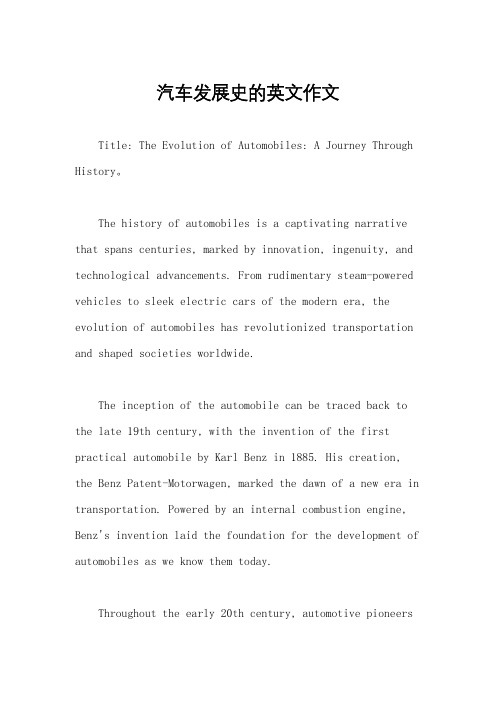
汽车发展史的英文作文Title: The Evolution of Automobiles: A Journey Through History。
The history of automobiles is a captivating narrative that spans centuries, marked by innovation, ingenuity, and technological advancements. From rudimentary steam-powered vehicles to sleek electric cars of the modern era, the evolution of automobiles has revolutionized transportation and shaped societies worldwide.The inception of the automobile can be traced back to the late 19th century, with the invention of the first practical automobile by Karl Benz in 1885. His creation, the Benz Patent-Motorwagen, marked the dawn of a new era in transportation. Powered by an internal combustion engine, Benz's invention laid the foundation for the development of automobiles as we know them today.Throughout the early 20th century, automotive pioneerssuch as Henry Ford played a pivotal role in popularizing automobiles and making them accessible to the masses.Ford's introduction of the assembly line revolutionized the manufacturing process, leading to increased production efficiency and lower costs. This, in turn, made cars more affordable for the average consumer, fueling the rapid growth of the automotive industry.The early decades of the 20th century also saw significant advancements in automotive technology,including the introduction of electric starters, pneumatic tires, and hydraulic brakes. These innovations not only improved the performance and safety of automobiles but also enhanced the overall driving experience.The mid-20th century witnessed further innovations in automotive design and engineering. The introduction of automatic transmissions, power steering, and air conditioning systems made cars more comfortable and convenient to drive. Meanwhile, advancements in aerodynamics and engine technology led to improvements in fuel efficiency and performance.The latter half of the 20th century saw a growing focus on environmental concerns and fuel efficiency. This prompted the development of alternative fuel vehicles, such as hybrid and electric cars. While these technologies were initially met with skepticism, they have since gained traction as concerns over climate change and fossil fuel dependency have intensified.In recent years, the automotive industry has witnessed a surge in innovation driven by digitalization and connectivity. The emergence of autonomous driving technologies, artificial intelligence, and internet-enabled features has transformed the way we interact with cars. Vehicles are now equipped with advanced driver assistance systems, GPS navigation, and entertainment options that were once unimaginable.Furthermore, the shift towards electric vehicles has gained momentum, with major automakers investing heavily in electrification initiatives. Electric cars offer numerous advantages, including lower emissions, reduced reliance onfossil fuels, and quieter operation. As battery technology continues to improve, the range and performance of electric vehicles are steadily increasing, making them a viable alternative to traditional combustion engine cars.Looking ahead, the future of automobiles promises even greater advancements and innovation. Emerging technologies such as hydrogen fuel cells, 3D printing, and advanced materials hold the potential to revolutionize the automotive industry once again. Moreover, the integration of smart infrastructure and vehicle-to-everything (V2X) communication systems will pave the way for safer, more efficient transportation networks.In conclusion, the history of automobiles is a testament to human creativity, perseverance, and ingenuity. From humble beginnings to cutting-edge innovations, the evolution of automobiles has shaped the course of history and transformed the way we live, work, and travel. As we stand on the cusp of a new era of mobility, the journey of the automobile continues to inspire and captivate us with endless possibilities for the future.。
汽车发展史【英文版】

Cadillac
Smaller air resistance, but narrow space and bad stability with cross wind.
➢ History---old stories
Real Automobile Era
Changed the style to be better!
➢The history of the car
Name: Student id:
➢ Car culture
How much do you
know about cars?
• Vehicle history • Auto and logo show • Conception car
➢ History---elder stories
Three Box Car (Boat) 1950s
For d
Chevrolet
Buick Cadillac
The world's largest number of a kind of models!
Conquered the instability with cross wind, but cannot run at high speed because of the strong air eddy.
Karl Benz made the first gasoline engine and used on the first 3 wheels automobile; Daimler manufactured the first four wheels car!
French, America, England, Japan and Russia started to their automobile era.
汽车发展史的英文作文
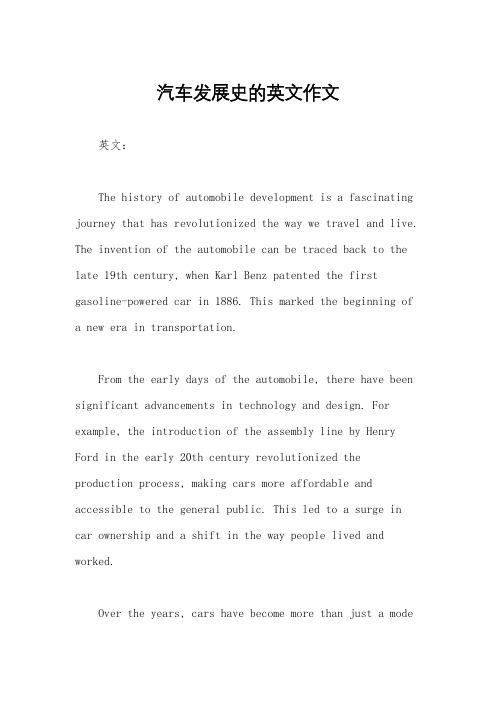
汽车发展史的英文作文英文:The history of automobile development is a fascinating journey that has revolutionized the way we travel and live. The invention of the automobile can be traced back to the late 19th century, when Karl Benz patented the first gasoline-powered car in 1886. This marked the beginning of a new era in transportation.From the early days of the automobile, there have been significant advancements in technology and design. For example, the introduction of the assembly line by Henry Ford in the early 20th century revolutionized the production process, making cars more affordable and accessible to the general public. This led to a surge in car ownership and a shift in the way people lived and worked.Over the years, cars have become more than just a modeof transportation. They have become a symbol of freedom, independence, and status. People often use phrases like "hitting the road" or "going for a drive" to express the joy and excitement of driving. Cars have also become a reflection of personal style and identity, with phrases like "car enthusiast" or "car culture" highlighting the passion and community surrounding automobiles.In recent years, there has been a growing emphasis on sustainability and innovation in the automotive industry. The development of electric and hybrid cars, as well as advancements in autonomous driving technology, are shaping the future of transportation. Phrases like "going green" and "driving into the future" capture the shift towards more environmentally friendly and technologically advanced vehicles.Overall, the history of automobile development is a testament to human ingenuity and progress. From the invention of the first car to the advancements in technology and design, cars have had a profound impact on our lives and society as a whole.中文:汽车发展史是一个迷人的旅程,它彻底改变了我们的出行方式和生活方式。
汽车发展历史的有关介绍英语作文
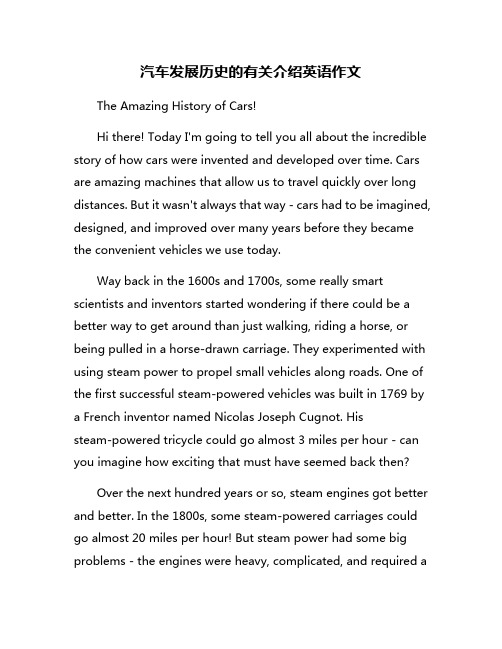
汽车发展历史的有关介绍英语作文The Amazing History of Cars!Hi there! Today I'm going to tell you all about the incredible story of how cars were invented and developed over time. Cars are amazing machines that allow us to travel quickly over long distances. But it wasn't always that way - cars had to be imagined, designed, and improved over many years before they became the convenient vehicles we use today.Way back in the 1600s and 1700s, some really smart scientists and inventors started wondering if there could be a better way to get around than just walking, riding a horse, or being pulled in a horse-drawn carriage. They experimented with using steam power to propel small vehicles along roads. One of the first successful steam-powered vehicles was built in 1769 by a French inventor named Nicolas Joseph Cugnot. Hissteam-powered tricycle could go almost 3 miles per hour - can you imagine how exciting that must have seemed back then?Over the next hundred years or so, steam engines got better and better. In the 1800s, some steam-powered carriages could go almost 20 miles per hour! But steam power had some big problems - the engines were heavy, complicated, and required alot of water and fuel. Plus they released a ton of smoke and were pretty loud. Scientists realized they needed to find a new way to power vehicles.That's when some geniuses started experimenting with gasoline engines! The first gasoline-powered automobile is credited to two German inventors named Karl Benz and Gottlieb Daimler in the 1880s. Their early "horseless carriages" were three-wheeled vehicles powered by a small gasoline engine. Not long after, in 1893, Brothers Charles and Frank Duryea built and road-tested the first successful gasoline-powered car in the United States.From those early inventions, cars just got bigger, better, and faster year after year. An American named Henry Ford realized that cars could be manufactured much more efficiently using something called an assembly line. In 1908, his company started mass-producing a simple, affordable car called the Model T. Suddenly, cars weren't just for the rich anymore - ordinary people could buy them too! Over 15 million Model Ts were made over the next 19 years.As the 1900s went on, cars got cooler styles and more powerful engines. Electric starters were added so you didn't have to crank the engine by hand. Closed metal bodies replaced opencarriage-styles. Luxury features like radios and heaters became available too. Automakers were always competing to make their cars faster, sleeker, and loaded with the latest gadgets.Of course, cars also got much safer over time. Things we take for granted today like seatbelts, airbags, crumple zones, and anti-lock brakes were all invented to help prevent injuries in crashes. Environmental concerns led to more fuel-efficient engines and emissions controls as well.Today's cars are technological marvels compared to those early "horseless carriages." Many run on electricity or hybrid gas-electric systems instead of gasoline alone. Some drive themselves using sensors and computers! Cars allow us to travel in comfort and safety at high speeds across cities, states, and even countries. Without the pioneering work of those inventors and engineers from long ago, we wouldn't have the amazing automobiles we enjoy today.I hope you found this look at the history and development of cars to be interesting! From steam to gasoline to electric power, it's been an incredible journey of creativity and innovation getting cars to where they are now. Who knows what amazing car technologies might be just around the corner? I can't wait to see what drivers will be cruising around in 100 years from now!。
英语作文汽车发展史180词
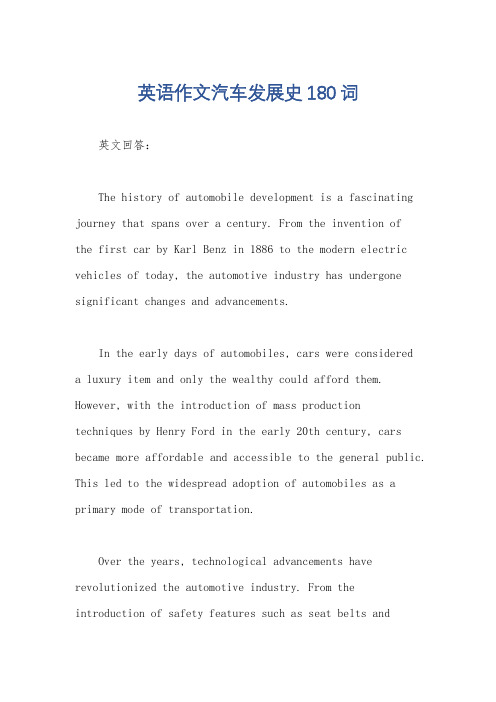
英语作文汽车发展史180词英文回答:The history of automobile development is a fascinating journey that spans over a century. From the invention ofthe first car by Karl Benz in 1886 to the modern electric vehicles of today, the automotive industry has undergone significant changes and advancements.In the early days of automobiles, cars were considereda luxury item and only the wealthy could afford them. However, with the introduction of mass productiontechniques by Henry Ford in the early 20th century, cars became more affordable and accessible to the general public. This led to the widespread adoption of automobiles as a primary mode of transportation.Over the years, technological advancements have revolutionized the automotive industry. From theintroduction of safety features such as seat belts andairbags to the development of self-driving cars, the industry has constantly evolved to meet the changing needs of consumers.One of the most significant developments in recent years is the rise of electric vehicles (EVs). With concerns about climate change and environmental sustainability, many car manufacturers are now focusing on producing electric cars that are more energy-efficient and environmentally friendly.In conclusion, the history of automobile development is a testament to human ingenuity and innovation. As technology continues to advance, we can expect to see even more exciting developments in the automotive industry in the years to come.中文回答:汽车发展史是一个跨越一个世纪的迷人旅程。
汽车历史发展的有关介绍英语作文
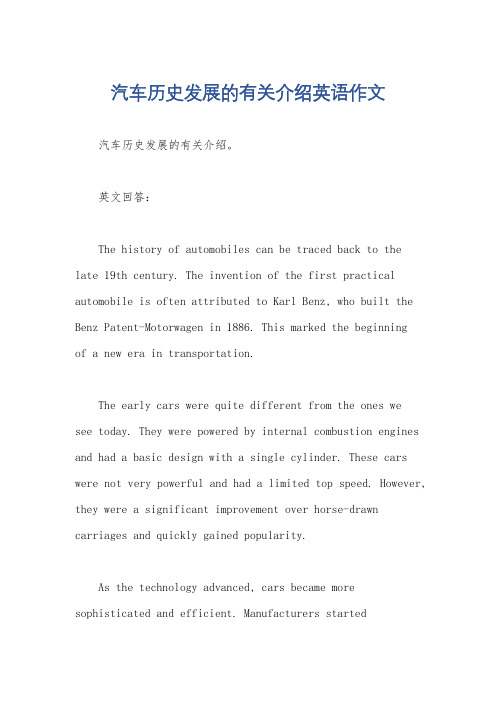
汽车历史发展的有关介绍英语作文汽车历史发展的有关介绍。
英文回答:The history of automobiles can be traced back to thelate 19th century. The invention of the first practical automobile is often attributed to Karl Benz, who built the Benz Patent-Motorwagen in 1886. This marked the beginningof a new era in transportation.The early cars were quite different from the ones wesee today. They were powered by internal combustion engines and had a basic design with a single cylinder. These cars were not very powerful and had a limited top speed. However, they were a significant improvement over horse-drawn carriages and quickly gained popularity.As the technology advanced, cars became more sophisticated and efficient. Manufacturers startedexperimenting with different engine configurations and designs. The introduction of the Ford Model T in 1908 revolutionized the automobile industry. It was the first car to be mass-produced using assembly line techniques, making it affordable for the average person.Over the years, cars have undergone numerous changes and improvements. The introduction of electric cars and hybrid vehicles has brought about a shift towards more environmentally friendly transportation options. Advanced safety features, such as airbags and anti-lock braking systems, have also become standard in modern cars.The automotive industry has had a significant impact on society and the economy. It has created jobs, stimulated economic growth, and provided people with a convenient mode of transportation. Cars have also become a symbol of status and personal freedom.中文回答:汽车的历史可以追溯到19世纪末。
汽车发展历史的有关介绍英语作文
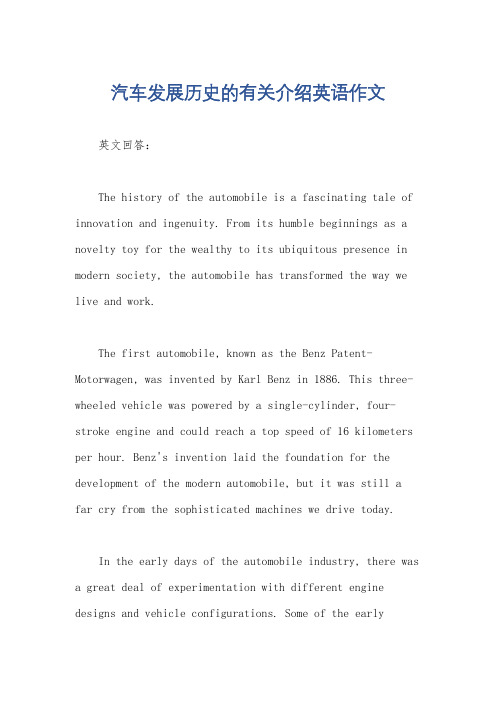
汽车发展历史的有关介绍英语作文英文回答:The history of the automobile is a fascinating tale of innovation and ingenuity. From its humble beginnings as a novelty toy for the wealthy to its ubiquitous presence in modern society, the automobile has transformed the way we live and work.The first automobile, known as the Benz Patent-Motorwagen, was invented by Karl Benz in 1886. This three-wheeled vehicle was powered by a single-cylinder, four-stroke engine and could reach a top speed of 16 kilometers per hour. Benz's invention laid the foundation for the development of the modern automobile, but it was still afar cry from the sophisticated machines we drive today.In the early days of the automobile industry, there was a great deal of experimentation with different engine designs and vehicle configurations. Some of the earlyautomobiles were powered by steam engines or electric motors, while others used gasoline-powered engines. By the turn of the 20th century, the gasoline-powered engine had become the dominant design, and it remains the most common type of engine in use today.The early automobiles were also quite expensive, and they were only affordable for the wealthy. However, as the industry matured and production methods became more efficient, the cost of automobiles began to decline. By the 1920s, automobiles were becoming increasingly affordablefor the average consumer, and car ownership became a symbol of middle-class status.The development of the automobile had a profound impact on society. It made it possible for people to travel greater distances more quickly and easily, and it opened up new possibilities for recreation and leisure. The automobile also played a major role in the development of the suburbs, as people were able to live further away from their workplaces and still commute to work each day.Today, the automobile is an integral part of modern life. It is used for transportation, recreation, and work. The automobile industry is also a major economic force, employing millions of people around the world.中文回答:汽车的发展历史是一部关于创新和创造力的迷人故事。
汽车发展史演讲稿英文简短
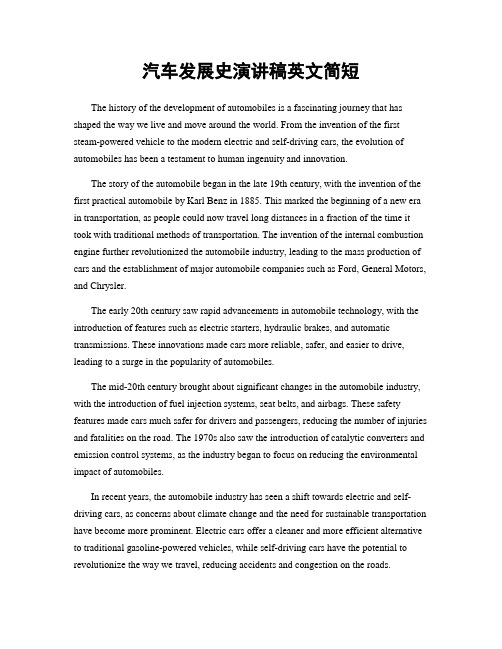
汽车发展史演讲稿英文简短The history of the development of automobiles is a fascinating journey that has shaped the way we live and move around the world. From the invention of the first steam-powered vehicle to the modern electric and self-driving cars, the evolution of automobiles has been a testament to human ingenuity and innovation.The story of the automobile began in the late 19th century, with the invention of the first practical automobile by Karl Benz in 1885. This marked the beginning of a new era in transportation, as people could now travel long distances in a fraction of the time it took with traditional methods of transportation. The invention of the internal combustion engine further revolutionized the automobile industry, leading to the mass production of cars and the establishment of major automobile companies such as Ford, General Motors, and Chrysler.The early 20th century saw rapid advancements in automobile technology, with the introduction of features such as electric starters, hydraulic brakes, and automatic transmissions. These innovations made cars more reliable, safer, and easier to drive, leading to a surge in the popularity of automobiles.The mid-20th century brought about significant changes in the automobile industry, with the introduction of fuel injection systems, seat belts, and airbags. These safety features made cars much safer for drivers and passengers, reducing the number of injuries and fatalities on the road. The 1970s also saw the introduction of catalytic converters and emission control systems, as the industry began to focus on reducing the environmental impact of automobiles.In recent years, the automobile industry has seen a shift towards electric and self-driving cars, as concerns about climate change and the need for sustainable transportation have become more prominent. Electric cars offer a cleaner and more efficient alternative to traditional gasoline-powered vehicles, while self-driving cars have the potential to revolutionize the way we travel, reducing accidents and congestion on the roads.Looking ahead, the future of automobiles is filled with exciting possibilities, from advancements in battery technology to the development of flying cars. As the automobile industry continues to evolve, one thing is certain: the history of automobiles is a testament to human innovation and the endless pursuit of progress.In conclusion, the history of the development of automobiles is a testament to human ingenuity and innovation. From the invention of the first practical automobile to the introduction of electric and self-driving cars, the automobile industry has come a long way. As we look towards the future, it is clear that the history of automobiles is still being written, with new advancements and breakthroughs on the horizon. The story of automobiles is a story of progress, and it is a story that continues to inspire and shape the world we live in.。
汽车发展史的英文作文
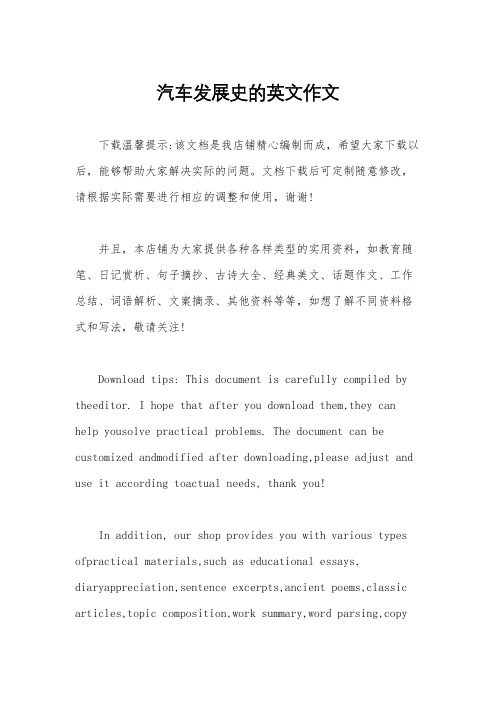
汽车发展史的英文作文下载温馨提示:该文档是我店铺精心编制而成,希望大家下载以后,能够帮助大家解决实际的问题。
文档下载后可定制随意修改,请根据实际需要进行相应的调整和使用,谢谢!并且,本店铺为大家提供各种各样类型的实用资料,如教育随笔、日记赏析、句子摘抄、古诗大全、经典美文、话题作文、工作总结、词语解析、文案摘录、其他资料等等,如想了解不同资料格式和写法,敬请关注!Download tips: This document is carefully compiled by theeditor. I hope that after you download them,they can help yousolve practical problems. The document can be customized andmodified after downloading,please adjust and use it according toactual needs, thank you!In addition, our shop provides you with various types ofpractical materials,such as educational essays, diaryappreciation,sentence excerpts,ancient poems,classic articles,topic composition,work summary,word parsing,copyexcerpts,other materials and so on,want to know different data formats andwriting methods,please pay attention!The history of automobiles can be traced back to the late 19th century when the first gasoline-powered car was invented. It was a revolutionary invention that changed the way people traveled and transported goods. Since then, cars have undergone significant developments and improvements in terms of design, technology, and performance.The early cars were simple and basic, with limited features and capabilities. They were mainly used by the wealthy and were considered a luxury item. However, as technology advanced, cars became more affordable and accessible to the general public. This led to a significant increase in the number of cars on the roads, which in turn had a profound impact on society and the economy.Over the years, car manufacturers have continued to innovate and push the boundaries of what is possible. From the introduction of electric and hybrid vehicles to the development of self-driving cars, the automotive industryhas witnessed remarkable advancements. These advancements have not only improved the efficiency and sustainability of cars but have also made them safer and more convenient to use.In addition to technological advancements, the design of cars has also evolved significantly. From the sleek and stylish models of the 1950s to the futuristic and aerodynamic designs of today, cars have become a symbol of status and personal expression. The emphasis on aesthetics and comfort has become a key selling point for car manufacturers, as consumers seek not only functionality but also style and luxury.The impact of cars on the environment and public health has also become a major concern in recent years. With the rise of air pollution and greenhouse gas emissions, there has been a growing demand for eco-friendly and sustainable transportation options. This has prompted car manufacturers to invest in alternative fuel technologies and develop more fuel-efficient vehicles to reduce their carbon footprint.In conclusion, the history of automobiles is a testament to human ingenuity and innovation. From the invention of the first gasoline-powered car to the development of electric and self-driving vehicles, cars have come a long way. As we look to the future, it is clear that the automotive industry will continue to evolve and shape the way we live and travel.。
世界汽车发展史
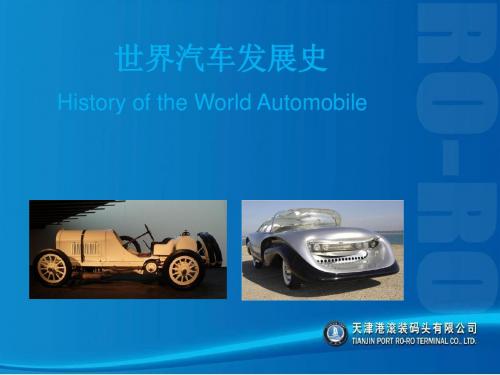
(6)仓背乘用车
(7)旅行车
(8)多用途乘用车
MPV:Mini Passenger Van, 本意是小型乘用厢式车,后 来由法国雷诺公司对这种车 型进行了改进,把折叠的概 念引入了第二和第三排座椅, 所以从那之后MPV便引申为 Multi Purpose Vehicle,强 调了多功能性,是集轿车、 旅行车和商务车于一身的车 型。 SUV是英文Sports Utility Vehicles的缩写,意 思是“运动型多用途汽车”。 SRV是Small Recreation Vehicle,“小型休闲车”, 一般指两厢轿车,比如上海 通用赛欧。
1、乘用车(不超过9座) (1)普通乘用车
(2)活顶乘用车
(3)高级乘用车
(4)小型乘用车
(5)敞篷车
活顶与敞篷的区别: 1. 定义不同。中国乘 用车分类中活顶乘用 车指车顶至少有两个 位置,第一个位置封 闭,第二个位置开启 或拆除.敞蓬车指车顶 至少有两个位置,第 一个位置遮覆车身, 第二个位置卷收或可 拆除; 2. 车型不同, 前者包括顶可拆的吉 普和客车;后者一般 专指轿车。
1769年,法国陆军工程师古诺发明了一台蒸汽汽车。
1865年,英国颁布了世界上第一部机动车安全法规—红旗法。
1866年,德国工程师奥托成功研制出在动力史上有划时代意 义的“活塞式四冲程奥托内燃机”,他的发明是继蒸汽机出 现之后,对人类的又一巨大贡献,为汽车的发明解决了最关 键的技术难题,为汽车的诞生奠定了坚实的基础。
1891年,法国人阿尔芒.标致首次采用前 置发动机后驱动形式,奠定了汽车传动 系的基本构造。
1898年,法国人路易斯.雷诺将万向节首 次应用于汽车传动,并发明了锥齿轮式 主减速器。
在百余年的汽车发展史中世界汽车业经历了三次 巨大变革。
汽车发展史(英文展示ppt)
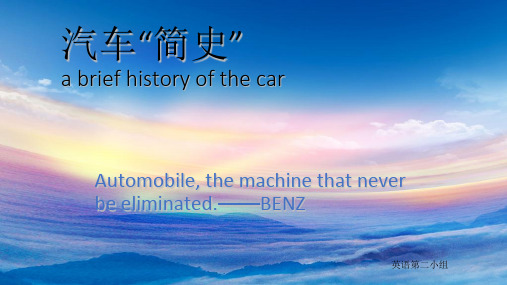
The first car
The first gasoline car
汽车发展史
October 1885 , Carl Benz , designed and manufactured a gasoline loading threewheel car .
high-speed like planes computer control,safer
less more humanzied design
multifunctional less accident
general speed not snsitive enough
large more defects
丰田购买福特汽车的引擎,研究并研发自己的产品。 在精益生产方式的带领下,丰田走在日本汽车制造商 的前沿,然后也逐渐成为世界领先的汽车制造商。
汽车发展史
The most famous automobile brands:
USA: General Motors 通用 Ford 福特 Europe: volkswagen 大众 daimler 戴姆勒 Japan: Toyota 丰田
(1885年10月,奔驰发明 了世界上第一台由汽油引 擎机发动的三轮车)
汽车发展史
After the 20th century , cars no longer just the Europeans dominated , Ford , invented Ford "T" car , which built water production line ,starting a new car period. (20世纪后,汽车不再只是欧洲人主 导,美国福特公司推出T型车并且发 明了流水线生产方式,将汽车行业领 入新时代。)
汽车的历史发展英语作文
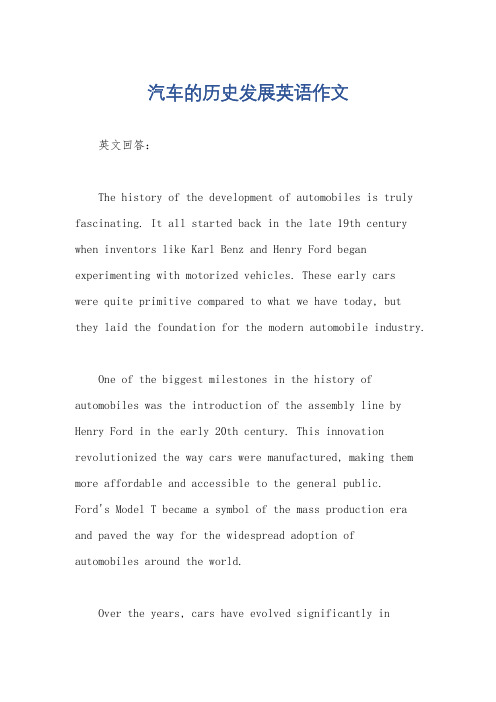
汽车的历史发展英语作文英文回答:The history of the development of automobiles is truly fascinating. It all started back in the late 19th century when inventors like Karl Benz and Henry Ford began experimenting with motorized vehicles. These early carswere quite primitive compared to what we have today, but they laid the foundation for the modern automobile industry.One of the biggest milestones in the history of automobiles was the introduction of the assembly line by Henry Ford in the early 20th century. This innovation revolutionized the way cars were manufactured, making them more affordable and accessible to the general public.Ford's Model T became a symbol of the mass production era and paved the way for the widespread adoption ofautomobiles around the world.Over the years, cars have evolved significantly interms of design, technology, and performance. From the sleek and aerodynamic sports cars of the 1960s to the fuel-efficient hybrids and electric vehicles of today, the automotive industry has come a long way. Innovations like automatic transmission, power steering, and advanced safety features have made driving more convenient and safer than ever before.I remember growing up in the 90s and dreaming about owning a flashy sports car one day. The thrill of driving fast and feeling the wind in my hair was something I always looked forward to. But now, as I've gotten older, I appreciate the comfort and reliability of a luxury sedan or SUV. The advancements in car technology have made long road trips a breeze, with features like adaptive cruise control and lane-keeping assist taking the stress out of driving.Overall, the history of automobiles is a testament to human ingenuity and innovation. From the early pioneers of the industry to the cutting-edge technologies of today, cars have become an essential part of our daily lives. Whether it's commuting to work, running errands, or goingon a road trip, cars have made transportation more convenient and enjoyable for people all over the world.中文回答:汽车的发展历史真是令人着迷。
关于汽车发展史的英语作文

关于汽车发展史的英语作文英文回答:History of Automobiles.The development of automobiles has revolutionized human transportation. In the early 19th century, inventors were experimenting with steam-powered vehicles. In 1885, Karl Benz developed the first internal combustion engine, which used gasoline as fuel. This invention marked the birth of the modern automobile.In the early 20th century, automobiles became more affordable and accessible to the general public. HenryFord's introduction of the Model T in 1908 made cars affordable for the average American family. Over the years, automobiles have undergone significant improvements in performance, safety, and comfort.Today, automobiles are an integral part of our dailylives. They provide convenient and efficient transportation, allowing us to travel far distances quickly and easily. Automobiles have also played a crucial role in economic development, creating jobs and fostering trade.中文回答:汽车发展史。
汽车的历史发展英语作文
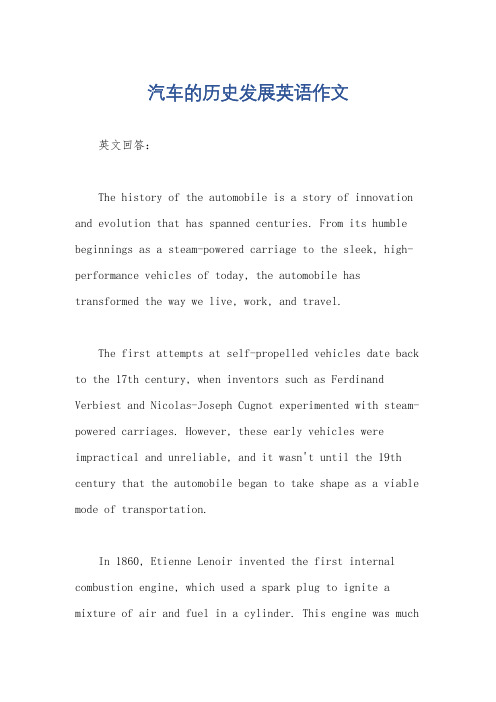
汽车的历史发展英语作文英文回答:The history of the automobile is a story of innovation and evolution that has spanned centuries. From its humble beginnings as a steam-powered carriage to the sleek, high-performance vehicles of today, the automobile has transformed the way we live, work, and travel.The first attempts at self-propelled vehicles date back to the 17th century, when inventors such as Ferdinand Verbiest and Nicolas-Joseph Cugnot experimented with steam-powered carriages. However, these early vehicles were impractical and unreliable, and it wasn't until the 19th century that the automobile began to take shape as a viable mode of transportation.In 1860, Etienne Lenoir invented the first internal combustion engine, which used a spark plug to ignite a mixture of air and fuel in a cylinder. This engine was muchmore efficient than steam engines, and it paved the way for the development of the modern automobile.In 1885, Karl Benz built the first successful gasoline-powered automobile. Benz's vehicle was a three-wheeled, open-top carriage that could reach speeds of up to 10 miles per hour. This invention marked the birth of the modern automobile industry, and it wasn't long before other inventors and manufacturers entered the field.In 1893, Henry Ford founded the Ford Motor Company, which would go on to revolutionize the automobile industry. Ford's Model T, introduced in 1908, was the first mass-produced automobile, and it made cars affordable for millions of Americans.The early 20th century saw rapid advancements in automobile technology. Electric starters, headlights, and closed bodies became standard features, and cars became more comfortable and convenient to drive. By the 1920s, the automobile had become an essential part of American life, and it continued to play a vital role in the development ofthe United States and other countries around the world.Today, the automobile industry is a global powerhouse, with manufacturers from around the world competing for market share. Cars have become increasingly sophisticated, with advanced safety features, fuel-efficient engines, and cutting-edge technology. The future of the automobile is uncertain, but it is clear that this remarkable invention will continue to play a major role in our lives.中文回答:汽车的历史是一部跨越数个世纪的创新和演变史。
英语作文汽车发展史英语作文
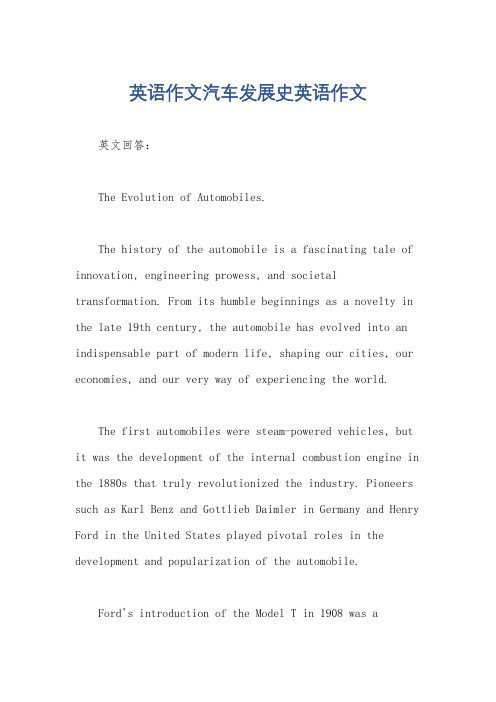
英语作文汽车发展史英语作文英文回答:The Evolution of Automobiles.The history of the automobile is a fascinating tale of innovation, engineering prowess, and societal transformation. From its humble beginnings as a novelty in the late 19th century, the automobile has evolved into an indispensable part of modern life, shaping our cities, our economies, and our very way of experiencing the world.The first automobiles were steam-powered vehicles, but it was the development of the internal combustion engine in the 1880s that truly revolutionized the industry. Pioneers such as Karl Benz and Gottlieb Daimler in Germany and Henry Ford in the United States played pivotal roles in the development and popularization of the automobile.Ford's introduction of the Model T in 1908 was awatershed moment. Its affordability and practicality madeit possible for the average person to own a car, transforming transportation and creating new possibilities for travel and commerce.In the first half of the 20th century, the automobile industry underwent rapid technological advancements. Electric starters, hydraulic brakes, and automatic transmissions made cars safer and easier to operate. The invention of the assembly line allowed for mass production, further driving down costs and making cars more accessible.Post-World War II, the automobile industry flourished. The rise of suburbs and the growth of the middle class created a huge demand for cars. Manufacturers responded with a wide range of models, from compact and economical to luxurious and powerful.In recent decades, environmental concerns have become increasingly important. The development of hybrid and electric vehicles, as well as advancements in fuel efficiency, have made cars more environmentally friendly.Self-driving cars and other autonomous vehicle technologies are also on the horizon, promising to transform the way we interact with our vehicles.中文回答:汽车的发展史。
英语作文汽车发展史英语作文
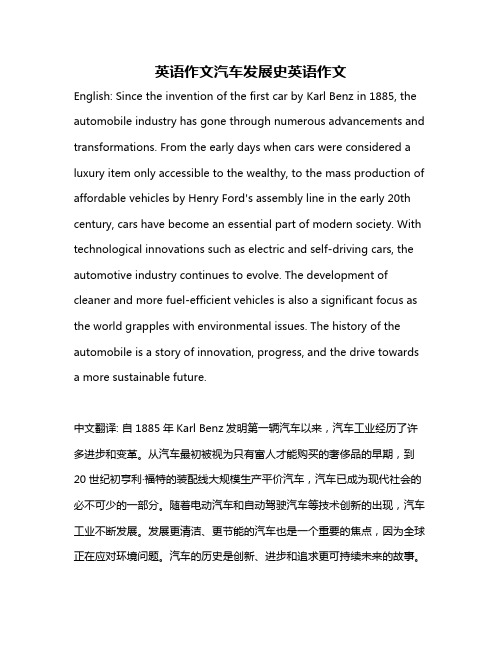
英语作文汽车发展史英语作文English: Since the invention of the first car by Karl Benz in 1885, the automobile industry has gone through numerous advancements and transformations. From the early days when cars were considered a luxury item only accessible to the wealthy, to the mass production of affordable vehicles by Henry Ford's assembly line in the early 20th century, cars have become an essential part of modern society. With technological innovations such as electric and self-driving cars, the automotive industry continues to evolve. The development of cleaner and more fuel-efficient vehicles is also a significant focus as the world grapples with environmental issues. The history of the automobile is a story of innovation, progress, and the drive towards a more sustainable future.中文翻译: 自1885年Karl Benz发明第一辆汽车以来,汽车工业经历了许多进步和变革。
- 1、下载文档前请自行甄别文档内容的完整性,平台不提供额外的编辑、内容补充、找答案等附加服务。
- 2、"仅部分预览"的文档,不可在线预览部分如存在完整性等问题,可反馈申请退款(可完整预览的文档不适用该条件!)。
- 3、如文档侵犯您的权益,请联系客服反馈,我们会尽快为您处理(人工客服工作时间:9:00-18:30)。
Top of automobile
of the car.
The first motor bike
❖ In 1885, the Germany’s engineer Daimler install the 1.1hp engine made by himself on a wood bicycle,then the first motor bike appeared.
The irst quadricycle(四轮车)
❖ In 1896, the Germany’s engineer Daimler fixed his 1.1hp gasoline-powered engine on a quadricycle with the help of his friend Wilhelm Maybach ,and this is the famous “Daimler 1”.
❖ 1956,the CA-10 4-ton Jiefang commercial truck was produced by the First Automobile Works
Development in china
explore and Growth stage
❖ 1958: The first 2½ ton light duty truck ❖ 1958: Nanjing Automobile Works, previously a vehicle
October 1885, Mercedes-Benz design and manufacture of a gasoline (汽油)loading three cars.
January 29, 1886, Mercedes-Benz was patented this day is recognized as the birthday
servicing unit of the Army, was established
Development in china
Rapid and comprehensive development stage
❖ Domestic(家庭的) passenger car production could not meet demand.
After Watt improved the steam engine (蒸汽 机),French Army Engineer Cugnot produced the first steam engine driving a car.
Carl. Mercedes-Benz(奔驰 汽车),now Germany's famous car company that is the first generation of fathers.
Development in china
❖ 1901, Cars first appeared in Shanghai ,imported from Hong Kong by Leinz, a Hungarian businessman.
❖ 1902, The first car owner was Empress Dowager Cixi of the Qing Dynasty
Future automobile
Characters of future cars
❖Diesel engine was absorbed by more cars; ❖Electric automobile will move into the practical
stage; ❖Automobile safety standards will be more strict; ❖New materials which may replace steel car
❖ China’s answer to the import binge was to sign a series of joint-venture(合资企业) passenger car production agreements.
❖ Several enterprises entered the automobile industry since 1994.
The most expensive automobile
❖ Silver ghost which was made by Rolls-Royce(劳斯莱斯) was the most expensive and famous automobile in the world. Silver ghost’s price is over 20 million pounds。It was the vehicle of the britain's queen Elizabeth. And it stopped producing at 1925.
Development in china
❖ 1928,Zhang Xueliang is the first men who organized to make automobile
Development in china
Start-up stage
❖ 1953,The first modern automobile factory First Automobile Works began production.
汽车发展史英文
Technical Background---the carriage(四轮马车)
Before the aotomobile come out, the carriage is the best land-based human transport.
Technical Background----industrial revolution
